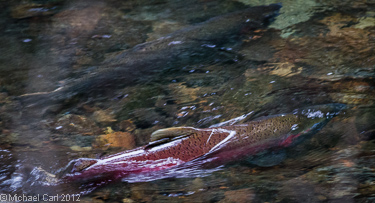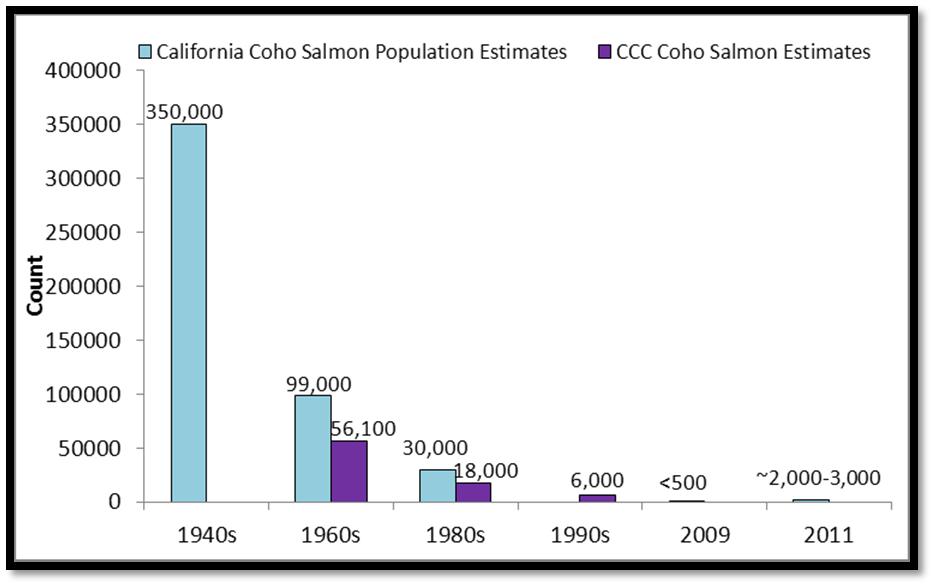Coho Info
The Quest for Coho
 In this feature story for Bay Nature I put down my flyrod (just for a while) and do some research. Driven by curiosity about the
coho salmon that once lived and spawned in the streams of the Santa Cruz and San Mateo Coast, I begin a three year quest to find them.
In this feature story for Bay Nature I put down my flyrod (just for a while) and do some research. Driven by curiosity about the
coho salmon that once lived and spawned in the streams of the Santa Cruz and San Mateo Coast, I begin a three year quest to find them.
Learn what I discovered and meet some of the folks dedicated to helping this fragile population survive in the
October - December 2012 issue of Bay Nature.
Distribution of Coho Salmon
Click on the image map to enlarge.
 The map depicts the historic distribution of Coho salmon in California.
The map depicts the historic distribution of Coho salmon in California.
Click on the image map to enlarge.
 The map depicts the current range of Coho salmon in California. (Note the dramatic reduction in their range above and below the city of San Francisco.)
The map depicts the current range of Coho salmon in California. (Note the dramatic reduction in their range above and below the city of San Francisco.)
The Central California Coho Ebook
Today, fisheries biologists fear coho salmon have entered an extinction vortex along the Central Coast of California. Is extinction inevitable or can we recover their populations in time?

To understand both the challenges to their survival and the recovery efforts, writer and photographer, Michael Carl, travels up and down California's Central Coast exploring their natal streams, talking to scientists and fishermen, and working alongside fisheries managers at a conservation hatchery.
In photographs and words this is their story.


Coho Conservation South of San Francisco
Listen to the podcast below, in which reporter Matthew Hansen interviews community members involved in the conservation of the coho salmon, including writer and photographer Michael Carl, as they explain why they work hard to preserve this ancient fish.
California Coho - Status
We found records of the historic occurrence of coho salmon in 582 streams, from the Smith River near the Oregon border to the Big Sur River on the central coast. No recent records were located on the presence or absence of fish in 58% of these streams. Of the streams for which we could find data from recent surveys, 54% still contained coho salmon and 46% did not. The status of coho salmon populations is best understood from Mendocino County southwards because of the historic importance of coho salmon in these streams compared to chinook salmon, concern for the effects of urbanization, and presence of agency fisheries biologists and others who have been concerned about the status of coho salmon.

Generally, the farther south a stream is located, the more likely it is to have lost its coho population. In Del Norte County, 45% of the streams for which we have reliable records have lost their coho populations, mainly in the Klamath-Trinity system. In Humboldt County, this drops to 31%, rising to 41% in Mendocino County, and 86% in Sonoma County. For streams south of Sonoma County, the figure is 56% but this is probably low as it does not include streams from the Sacramento drainage and includes streams with extremely low populations that are enhanced by hatchery production. Early accounts indicate that the Sacramento drainage did support coho salmon in the 19th century but the salmon were extirpated before any good records were kept. (Brown & Moyle 1991)
Historically, estimates of state-wide coho salmon abundance were simply guesses made by fisheries managers, presumably based on limited catch statistics, hatchery records, and personal observations of runs in various streams. In the 1940s, there were assumed to be about 1 million coho salmon spawning in the state, which dropped to about 100,000 fish in the 1960s. In the 1980s, the total was estimated to average around 33,500. Unfortunately, there is no way to test the reliability of these estimates and they should best be regarded as "ball-park" or "order of magnitude" estimates. Using the data available and guesses for streams without data (based on assumptions that should have resulted in overestimates of fish numbers), we estimated that the total number of adult coho salmon entering California streams in the last 3-5 years has averaged about 31,000 fish per year. However, fish from hatchery populations make up 57% of this total and many other populations probably contain at least some fish of recent hatchery ancestry. (Brown & Moyle 1991)
The general reasons for the decline of coho salmon in California are many and well known: poor land use practices, especially related to logging and urbanization, that alter streams and are exacerbated by floods and drought; alteration of the genetic integrity of wild stocks through planting of hatchery fish from distant locations; introduced diseases; over harvest; climatic change etc. However, the problems have not been well defined for individual drainages, which is where management efforts must be focused. Management goals put forward by the California Department of Fish and Game could reverse the trends if properly implemented but this will require a major effort involving increased funding, considerable interagency cooperation, and development of an extensive monitoring program. (Brown & Moyle 1991)
The challenges of managing such a diffuse resource as coho salmon are considerable but if we do not start reversing the population declines soon, we are likely to lose the southernmost populations of this species, a unique genetic, aesthetic, and economic resource. Coho salmon in California probably qualify for listing as a threatened species under state law and a number of populations may qualify for listing as threatened or endangered under federal law. We recommend, however, that state-wide listing be postponed provided immediate efforts are made to reverse the decline, to see if cooperative rather than coercive methods can be made to work to protect the species. We do suggest, however, that the population in Scott Creek, Santa Cruz County, be listed as endangered, to ensure the continued existence of the southernmost, genetically pure population. (Brown & Moyle 1991)
Fish Species of Special Concern in California, Coho Salmon. CA Dept of Fish and Game, 1995 Central California
Nine coastal streams south of San Francisco Bay historically supported self-sustaining spawning runs of coho salmon. These streams are San Gregorio, Pescadero, Gazos, Waddell, Scott and San Vincente creeks, the San Lorenzo River, and Soquel and Aptos creeks in San Mateo and Santa Cruz counties. Presently, only Scott Creek is known to support all three brood-year lineages. A lineage is defined as the direct ancestor-descendent line. For the southern populations of coho salmon, there are three distinct and separate maternal brood-year lineages. The Scott Creek population has been supplemented in recent years by stocking of coho juveniles from a small hatchery on Big Creek, a tributary of Scott Creek.
Waddell Creek, five miles north of Scott Creek, is known to support two of the three brood-year lineages, although one of the two appears to total less than 20 returning adults.
The size of the coho salmon populations in these coastal streams is not known; however, some limited sampling for juvenile coho salmon has been conducted on all the streams. Juveniles have been found in Pescadero, Gazos, Waddell, Scott, and San Vicente creeks. However, due to the difficulties in sampling, it has not been possible to estimate juvenile population sizes. The few existing southern coho salmon populations are small and in danger of extirpation.
The decline of southern coho is primarily due to unfavorable climate conditions in recent decades. Droughts during the 1970s and 1990, intense floods in the 1980s and late 1990s, and recent unfavorable ocean conditions have all contributed substantially to the continuing decline of southern coho salmon. Very poor (warm, nutrient-poor) ocean conditions in the fall of 1997 resulted in most adult coho returning to central coast streams having very poor fertility. In addition most of the limited production from this group of adults was probably destroyed by extraordinarily high rainfall amounts in February 1998, and associated high levels of streambed scour. More favorable ocean and precipitation conditions during the winter of 1998-99 produced a substantial 1999 year-class. Fall 1999 juvenile surveys have found evidence of successful reproduction in Pescadero, Gazos, Scott, Waddell, and San Vicente creeks. Approximately 4,000 juvenile coho are being reared at the Big Creek Hatchery for release in the spring of 2000 State Status: Endangered, December 1995 (limited to Coho south of San Francisco Bay)
NMFS - 1994 Status Reivew of Scott and Waddell Creeks
Population Trends - The petitioners stated ... Scott and Waddell Creeks have lost over 90% of their average documented runs of 50 years ago. They also estimated that the coho salmon populations within Scott and Waddell Creeks have declined 5% to 98% from the historical runs of the 1800's. The petitioners cited (Smith 1992) which reported that only 42 juvenile coho were found in Scott Creek and 19 juvenile coho were found in Waddell Creek.
An adult migrant trap was operated in Waddell Creek in the winter of 1992-92 and captured 31 adult coho which represented one-half of the adult run based upon recovery of marked carcasses (Smith 1992). Smith found that most coho were grilse males (aged 1.1), and approximately 8 females were estimated for 1991-92 run. In 1992-93, one coho adult was trapped in Waddell Creek, however Smith (1993) reported that trapping efficency was very poor or non-existent due to high storm flows during two-thirds of the adult coho spawning run from mid-December through mid-February.
The present adult spawning run in Waddell Creek is about 50 fish in a decent year and much less in poor years(Smith 1993). Surveys of juvenile coho salmon indicate that Waddell Creek only has a good run every third year; the most recent in 1990, with poor 1988 and 1989 year class production (Brown and Moyle 1991, Smith 1993). The annual coho returns estimated by Shapovalov and Taft (1954) during the 1930's and early 1940's compared to 1992-93 estimated adult coho run size (Smith 1993) indicates there is an 84 percent reduction in the numbers of returning adult coho salmon to Waddell Creek over the last 50-60 years.
Bleak Outlook for Coho
In 2008, Coho watchers got a sour surprise earlier this year when adults came back to spawn in pitiful numbers that represented a 70 percent decline from previous years. In Scott Creek—at the southern end of the fish’s range— just 11 fish returned to spawn, and only one was female. Sean Hayes, a biologist with the National Marine Fisheries Service, says it’s too early to tell what the coho return will be like this year. It takes a good, healthy rain to breach the sandbar at the end of creeks like Scott and Waddell so the coho that have been feeding in the ocean can make it back upstream to spawn. Hayes says that usually happens in mid-December, with the first serious storm of the season. “We’re probably expecting somewhere on the order of 50 fish if things are mediocre to slightly poor to 100 if things go really well,” he says. “A good year of coho in the creek is 300 or more fish. Two hundred we’re happy with, and 100 we can get by with. And less than that and we’re worried.”
Photo of California Coho Salmon by P. Michael Carl © The Ecological Angler


